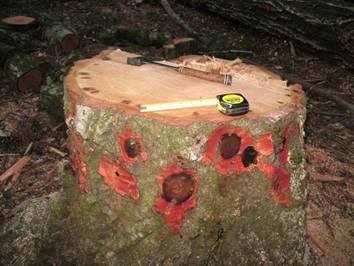
Stem injection involves introducing a chemical into the water-conducting tissues of a tree (xylem) via holes drilled into the outer sapwood. To speed uptake, the solution is applied under slight to moderate pressure. Some injectors apply the chemical to the cambial region, which may allow some of the chemical to be directly absorbed by the phloem. Current recommendations for injecting with potassium phosphite products are discussed below. These practices are subject to change based on the outcome of ongoing studies. Timing: Trees should be injected at least 4 to 6 weeks before the onset of conditions favorable for disease because of the time lag between injection and subsequent translocation of phosphite throughout the plant. Repeat injections at 1.5- to 2-year intervals, depending on the timing of the previous treatment. For instance, if the end of the 1.5-year interval falls in the summer, injection may be delayed until fall.
For low pressure injectors, trees must be actively transpiring in order to take up injected phosphite solution. Deciduous trees such as California black oak should be injected when expanded leaves are present. The fastest uptake of injected solution occurs under sunny conditions. Uptake may be slow to negligible during rainy, foggy, or heavily overcast conditions. Uptake may also be slow late in the day, especially in dense, shaded stands. In very dry sites, uptake may be better with light cloud cover and cooler temperatures than under very hot, dry conditions.
Injection holes in the bark have an elevated susceptibility to P. ramorum infection, so trees should not be injected in late winter or spring. Injection is not recommended for trees under severe water stress because phytotoxicity may develop in the canopy. Foliar phytotoxicity may also develop if trees are injected when temperatures are above 32 °C (90 °F). Dose: Approximately 0.71 ml of nondiluted potassium phosphite formulation (45.8 percent potassium phosphite) per cm of stem diameter (1.75 ml/inch stem diameter) is a common label rate for tree injection. This dosage may not be adequate for large diameter trees. Different methods of calculating the applied dose provided on some labels can generate dosages up to about 10 times this level.
Concentrated potassium phosphite solutions (45.8 percent) must be diluted with water before injection, although dilution ratios have differed with the injector type. Dilutions of concentrated phosphite solution and water ranging from 1:2 to 1:5 (15.3 to 7.6 percent potassium phosphite) have caused significant phytotoxicity in injected tanoaks and coast live oaks. Injection holes exhibited prolonged bleeding (up to several years) and necrosis in the phloem and xylem (fig. 3-5).. Studies are underway to determine the dilution needed to avoid phytotoxicity. The dose needed to provide efficacy may also need to be adjusted for more dilute injection solutions.

Figure 3-5—Necrosis in phloem and xylem (dark brown discoloration) associated with injections of 15.3 percent potassium phosphite (10 ml per injection). Injections were made 2 and 4 years before the tree was cut. Outer bark has been chipped away around injection points.
Injection points: To ensure that injected material is evenly distributed throughout the tree canopy, injection points need to be spaced at relatively close intervals. Injectors are typically spaced 15 to 20 cm (6 to 8 inches) apart, but some injector manufacturers recommend wider spacing, up to 23 to 25 cm (9 to 10 inches). If injectors are spaced too widely, phosphite will not be evenly distributed throughout the canopy. The optimum injector spacing needed to ensure even distribution of phosphite in the lower trunk is currently unknown.
Injection holes should be at least 0.3 m above ground level to minimize contamination of the holes with soil, but the actual height of the injection holes is not critical. If bark is too thick to allow proper placement of the injectors (see below), insert injectors higher on the trunk where the bark is thinner. Drill holes level horizontally or angled with the opening pointing slightly downward so that water running down the stem will not collect in the holes.
Follow the injector manufacturer's instructions to select the diameter of the drill bit. Use a sharp drill bit to obtain a cleanly cut hole and use the bit to clear shavings from the hole before injection. For most injector types, holes should extend through the bark to the outer sapwood. If possible, clean the drill bit with isopropyl or ethyl alcohol (70 percent or higher) between each hole to prevent cross-contamination. At a minimum, clean the drill bit when moving from tree to tree. Clean injectors with 70 percent alcohol prior to use in another tree.
Ensure that the injector tip fits tightly into the hole to prevent leakage. For injectors that are designed to apply material into the sapwood, holes should extend about 1 cm into the sapwood. Some injectors allow phosphite solution to be injected into the inner bark and cambium area, but this has been associated with phloem necrosis at the dilutions noted above. Some injection systems employ a plastic plug with a septum that is inserted into the drill hole and remains in the tree. These plugs must be seated at the depth specified by the injector manufacturer.
Drill holes into healthy areas of the trunk. Avoid areas with dead bark, decayed wood, cracks, sunken areas, branch stubs, or callus tissue. Stagger the injection height, include a vertical offset of about 10 to 20 cm (4 to 8 inches) for adjacent holes to avoid placing all injection points in a single line around the tree's circumference. Drill new holes for injectors when retreating trees; do not reuse holes made for a previous injection. Offset new holes horizontally as far as possible from the previous set(s) of holes and use different vertical heights.
Applicator safety: Some injectors contain solution under pressure after filling. Take precautions while carrying or handling injectors and while making injections to ensure the solution is not unintentionally squirted at the applicator. A full face shield is preferable to goggles for persons handling injectors.